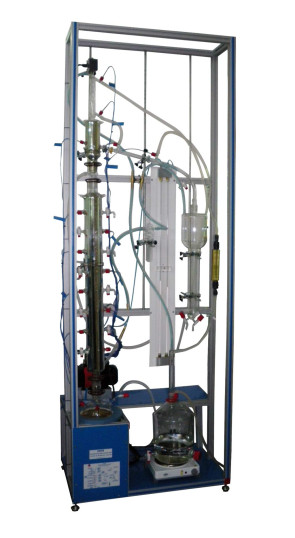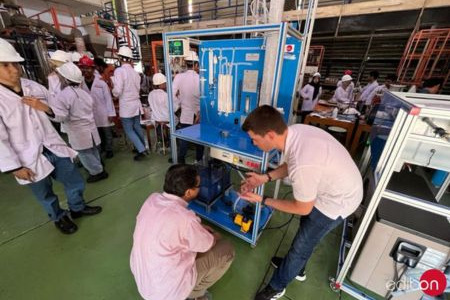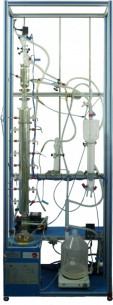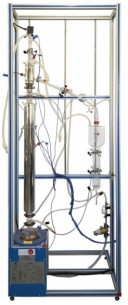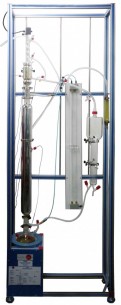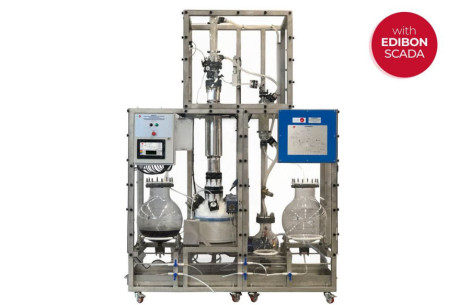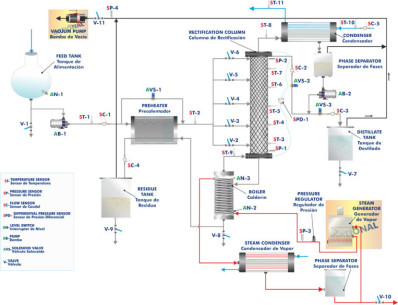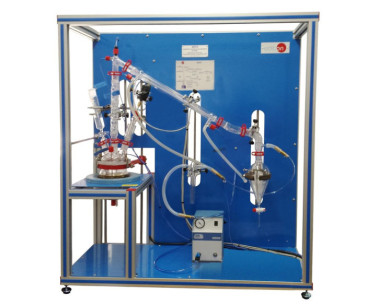Today we would like to tell you about our latest installation in Indonesia. At Institut Teknologi Sepuluh Nopember we have installed the following equipment. Our engineers came to the centre to install the equipment and explain how it works to the people responsible for using it.
UDCB Unit Destilasi Kontinu.
SISTEM INOVATIF
The Distillation Unit, "UDCB", designed by EDIBON, is a powerful laboratory tool for the study of variables affecting the distillation process. The student can investigate the principles that govern the transfer of matter and energy, as well as determine the optimum operating point for carrying out a large number of separations.
BERITA TERKAIT
GAMBARAN UMUM
The Continuous Distillation Unit, "UDCB", is formed by a boiler, on which different types of columns can be adapted (plate columns and Raschig columns). An eight plate column, a reflux system, a tank for distillation, a vacuum pump and a feeding pump (for continuous feeding) are included.
The steam reaching the head of the column is sent to a total condenser. The cooling water flow going through the condenser can be adjusted and is indicated in a flow meter. Distillation can be carried out at low pressures with the help of an adjustable vacuum pump. The load loss in the column can be measured with a pressure meter.
The column can work both continuously and discontinuously.
For proceeding to continuous feeding, a pump that can inject the substance directly into the boiler or in any of the plates is available.
The temperatures of the system are measured through sensors placed in strategic positions.
LATIHAN DAN PRAKTEK PEDOMAN
LATIHAN PRAKTIS YANG DIANDAL TERMASUK DALAM PANDUAN
- Preparation of solutions.
- Analytic valuation techniques.
- Filling of the column.
- Batch operation. Continuous operation.
- Obtaining the McCabe-Thiele diagram. Without reflux.
- Obtaining the number of plates. Without reflux.
- Efficiency calculations. Without reflux.
- Variation of the composition of the distilled product: constant reflux ratio.
- Constant composition of the distilled product: variation of reflux ratio.
- Constant composition of the distilled product: constant reflux ratio.
- Continuos feeding of the column.
- Mass and energy balances across the system.
- Plates fluid dynamics studies, including load loss and column flooding.
- Study of the feed temperature effect on the continuos processes.
- Calculation of the theoretical number of floors in the plates columns,and the equivalent height of the theoretical floor ( HEPT) in the Raschig rings columns.
- Pursuit of the temperatures in all plates in the column (Plates columns).
- Study of the rectification efficiency at different pressures.
- Effect of feed pre-heat.
- Effect of feed position.
- Demonstration of azeotropic distillation.
- Studies of heating interchange in glass refrigerators.
PERALATAN SIMILAR TERSEDIA
11.1.4.- DISTILASI DAN RETAK
UDCC
The Computer Controlled Continuous Distillation Unit, "UDCC", is basically composed by a boiler on which different types of columns can be adapted (plate columns and Raschig rings column). An eight plate column, a reflux system, a tank for...
11.1.4.- DISTILASI DAN RETAK
UDDC
Unit Komputer Kontrol Destilasi.
The Computer Controlled Batch Distillation Unit, "UDDC", is basically composed by a boiler on which different types of interchangeable columns can be adapted (plate columns and Raschig Rings column). An eight plate column, a reflux system and a...
11.1.4.- DISTILASI DAN RETAK
UDDB
Unit Destilasi.
Distillation is used to separate liquid mixtures made up of individual liquids that are soluble in one another.EDIBON's distillation unit, in its different versions, is one of the most powerful laboratory tools for the study of the variables that...
PERALATAN KOMPLEMENTER
11.1.4.- DISTILASI DAN RETAK
SRD/4/CTS
Computer Controlled and Touch Screen 4 l/h Solvent Recovery Distillation Unit
The Computer Controlled and Touch Screen 4 l/h Solvent Recovery Distillation Unit, "SRD/4/CTS", is able to show, for further investigation and study, the separation of water from a mixture composed of the organic solvent Gamma-Valerolactone (GVL)...
11.1.4.- DISTILASI DAN RETAK
UDCC/A
Advanced Computer Controlled Continuous Destillation Unit
The Advanced Computer Controlled Continuous Distillation Unit "UDCC/A" is an installation that allows the study of fractional distillation using a packed column which is able to operate with different packings.There is a feeding system that...
11.1.4.- DISTILASI DAN RETAK
UDCC
Unit Komputer Kontrol Destilasi Kontinu.
The Computer Controlled Continuous Distillation Unit, "UDCC", is basically composed by a boiler on which different types of columns can be adapted (plate columns and Raschig rings column). An eight plate column, a reflux system, a tank for...
11.1.4.- DISTILASI DAN RETAK
UDDC
Unit Komputer Kontrol Destilasi.
The Computer Controlled Batch Distillation Unit, "UDDC", is basically composed by a boiler on which different types of interchangeable columns can be adapted (plate columns and Raschig Rings column). An eight plate column, a reflux system and a...
11.1.4.- DISTILASI DAN RETAK
UDDB
Unit Destilasi.
Distillation is used to separate liquid mixtures made up of individual liquids that are soluble in one another.EDIBON's distillation unit, in its different versions, is one of the most powerful laboratory tools for the study of the variables that...
11.1.4.- DISTILASI DAN RETAK
QCCC
Unit Komputer Kontrol Keretakan Kolom
The Computer Controlled Cracking Column, "QCCC", for cracking and distilling oil is a complete lab tool that allows to the students to carry out a cracking reaction, and the study and the control of different variables that condition it. Also, the...
KUALITAS

LAYANAN PURNA JUAL

 Preferensi cookie
Preferensi cookie

